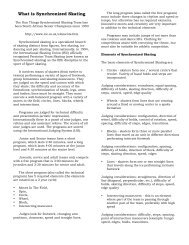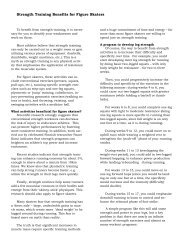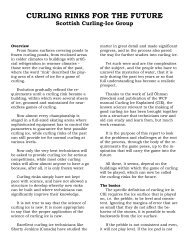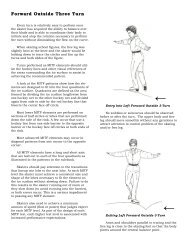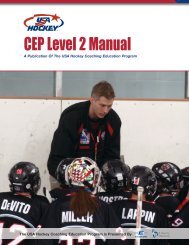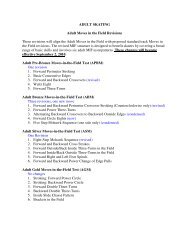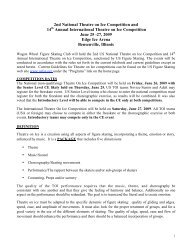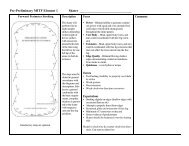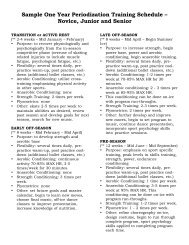CEP Level 3 Manual - Rushmore Hockey Association
CEP Level 3 Manual - Rushmore Hockey Association
CEP Level 3 Manual - Rushmore Hockey Association
Create successful ePaper yourself
Turn your PDF publications into a flip-book with our unique Google optimized e-Paper software.
T A B L E O F C O N T E N T Sperformance are listed and explained in thefollowing paragraphs.• Success should be possible for everyone onthe teamWhen implementing a goal-setting program,each athlete must experience some success; inother words, each player should perform at a levelthat demands a best effort for the existingconditions. Help each athlete realize that effortequals success by focusing rewards on such efforts.• Practice goals should be more challengingand goals during competition more realisticWhen you set up drills to work on passing orshooting, help your players set goals for practicethat will challenge them to exceed a previous effort.For example, when practicing slap shots, you mayask your best shooter to make seven out of 10 shotsin practice, while another player may be challengedwith four out of 10. You cannot expect the samelevel of performance in a game because neither younor the player control all the factors. Therefore, youmay set two or three out of 10 shots in a game as arealistic goal for your best and one out of 10 shotsfor your other players. With this approach,motivation at practice is increased and players havea realistic chance of experiencing self-worth in agame.• Goals should be flexibleIf goal-setting is to be effective, goals must beevaluated frequently and adjusted depending on theathlete’s success ratio. If an athlete is achieving theset goal, increase the goal to provide for greaterchallenge and motivation. If the goal is too difficultand the athlete is feeling frustration or failure, thegoal should be lowered rather than having theathlete continue to experience failure.• Set individual goals rather thanteam goalsIn general, team goals should not be made. Thisis because team goals are not under anyone’scontrol and they are often unrealistic. It is toodifficult to assess accurately how a team willprogress through a season. Will your team improvefaster than other teams, at the same pace or be alate-comer? If you set as a goal winning a certainnumber of games (i.e., 15 out of 20 games), and theteam loses their first six games, you cannot achievethe goal even by winning the remaining 14 games.This will only cause greater discouragement amongteam members. Work on individual improvementthrough goal-setting and let the team’s improvementreflect the individual’s improvement.Goal-setting can be very effective in improving aplayer’s performance, confidence and self-worth.To be effective, however, you must know yourplayers well enough to know when they are settinggoals that are challenging, controllable and realistic.In addition, goals must be adjusted to ensurefeelings of self-worth. Team goals should generallybe avoided.Dealing with Competitive StressSome coaches believe the best way to motivatea team for competition is to get them “psyched-up”before the game. With young athletes, however,getting “psyched-up” is not usually the problem;rather, the problem for them is getting “psychedout.”Competitive stress in young players canoriginate from many sources - the player,teammates, the coach, and/or the parents. Whenhockey players are asked what might cause them toworry, the five most frequent answers given were:improving their performance, participating inchampionship games, falling for a “sucker move,”performing up to their level of ability and what theircoach would think or say. Thus, young hockeyplayers are most likely to be worried aboutperformance failure. This worry about failure mayincrease players’ anxieties, which, in turn, may causepoor performance and eventually decreasemotivation.A good way to help your players avoid theeffects of competitive stress is to reduce their fearof failure. This can be achieved by encouragingthem to enjoy the game and do their best. Whenyour players lose or make a mistake, don’t expressdispleasure; rather correct their mistakes in apositive way by using the following steps.1. Start with a compliment. Find some aspectof the performance that was correct.2. Then tell the player what was wrong andhow to correct it.3. End with another positive statement suchas, “Keep working at it. You’llget it.”This approach allows players to keep practicingtheir skills without the fear of making a mistake. Thefollowing guidelines may be helpful in preventingcompetitive stress.1. Don’t set unrealistic goals.2. Use the positive approach when correctingmistakes.3. Eliminate the type of “pep talks” thatcommunicate overemphasis on the gameand the outcome.SUMMARYChildren play hockey because they want to havefun, be with friends, improve their skills and besuccessful. Children who drop out of hockeytypically do so because one or more of their goalswas not met. You can maximize your players’ desireto participate and help prevent them from droppingout by getting to know them as individuals. Learnwhy they are participating; focus on skilldevelopment in practice sessions and make sure thepractices are enjoyable. Allow time for friendshipsto develop by creating a cordial environment bothon and off the ice. Help players understand themeaning of success and have them set realisticgoals.Using a positive approach to coaching is themost effective way to improve players’performance. Positive coaching will also makeplaying and coaching more enjoyable. Be sure toreward effort and correct techniques, in addition tothe results that meet your expectations.Having realistic expectations of players’performance will provide more opportunities togive rewards. However, where players makemistakes, use the positive approach to correctingerrors. The positive approach involves using acompliment, correcting the error and thenfinishing with another positive statement. Using apositive approach and helping players reach theirgoals are effective ways to motivate your playerstoward maximum performance.REFERENCESSmoll, F.L., Smith, R.E. (1979). Improving relationship skills in youth sportcoaches. East Lansing, MI: Institute for the Study of Youth Sports.Youth Sports Institute (1977). Joint legislative study on youth sportsprogram, phase II. East Lansing, MI: Institute for the Study ofYouth Sports.48 | USA <strong>Hockey</strong> Coaching Education Program <strong>Level</strong> 3 <strong>Manual</strong>Sport Psychology | 49



